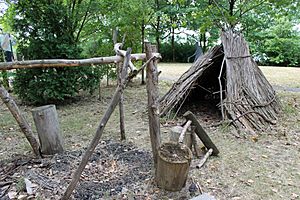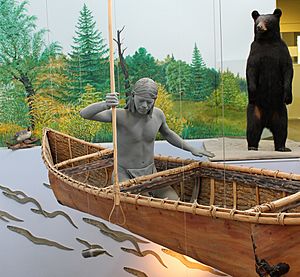Sainte Marie among the Iroquois facts for kids
| Sainte Marie de Ganentaa | |
 |
|
| Lua error in Module:Location_map at line 420: attempt to index field 'wikibase' (a nil value). | |
| Established | 1656 (Mission), 1930s (French "Fort"), 1990s (Mission Recreation) |
|---|---|
| Location | Liverpool, New York, United States |
| Type | park/living museum |
Sainte Marie among the Iroquois was a French Jesuit mission built in the 1600s. It was located near Onondaga Lake in what is now Syracuse, New York. The mission was first called Sainte Marie de Gannentaha. It was built in the middle of the Onondaga nation, who are part of the Iroquois people.
The original mission was only open for a short time, from 1656 to 1658. Today, there is a modern copy of the mission. It works as a museum and learning center. You can visit it between May and October. Sometimes, people dressed in old-fashioned clothes show what life was like back then. This is called a "living history" project.
Sainte Marie among the Iroquois is a living museum. It is part of the Onondaga County parks system. This means it is also a public park. Volunteers help run the site, create programs, and keep the displays looking good. The inside of the fort is currently being updated.
Contents
Exploring the Museum
The museum is a two-story building. It holds many old items from Onondaga County Parks. Visitors can see different exhibits and learn about the past. You can also book special tours for groups of all ages. There is a gift shop on the first floor where you can find souvenirs.
Discovering the Mission Site
The mission itself is located behind the museum. You can reach it from the second floor. Between the museum and the mission, there is a small camp with reed huts. The Haudenosaunee (Iroquois) and French used these types of camps when they traveled. They were often placed about a day's walk apart.
The main mission area is surrounded by a tall fence called a palisade. Inside, you will find a chapel, a dining hall (refectory), and a sleeping area (dormitory). There are also workshops for carpentry and blacksmithing, and pens for animals. Outside the palisade, you can see gardens with vegetables and herbs, and an oven for baking.
A Look at History
Why the Mission Was Built
The Jesuits built this mission because the Onondaga nation invited them. The Onondaga were part of the Iroquois Confederation. At that time, there was fighting between the Mohawks and the French in New France (now Quebec). The Onondaga wanted to help make peace.
The French built a strong fence and some buildings overlooking Onondaga Lake. French missionaries and workers lived there. Some French soldiers, called Coureur des bois (meaning "Runners of the Wood"), also came to protect the mission.
Why the Mission Was Left Behind
After two years, the Mohawks threatened to attack the mission. Also, a new French Governor was not as interested in the project. So, in 1658, everyone at the mission left safely. The French did not try to build any more missions in Iroquois territory after that.
The Rebuilt Mission and Museum
The First "French Fort"
In the 1930s, a copy of Sainte Marie de Ganentaa was built. This was part of a program called the WPA. However, it looked more like a "wild west" fort than a French mission. This might have been because people thought a "French fort" was built nearby in 1696. That "fort" was actually just a temporary camp of tents.
The new "French fort" was built close to the original mission site. From the 1970s, Onondaga County Parks ran the site. People dressed up and acted as French and Haudenosaunee characters. They would talk about the characters in the third person, like telling a story.
Making the Museum Better
In the early 1990s, the "Fort" was rebuilt. The goal was to make it look more like the real French mission. Money was raised, and grants helped pay for this big project. The new design was based on old writings from the Jesuits and other historical records. It also looked at a similar mission called Sainte Marie among the Hurons.
The new mission site was smaller than the old "French Fort." But a new museum and learning center were also built. This allowed Sainte Marie to show many different displays about Native and French culture from around the 1650s.
Changes and Reopening
By the early 2000s, Sainte Marie closed because fewer people were visiting. Also, there were budget cuts. But a group of people who cared about the site worked hard to get it reopened. They formed a group called the Friends of Historic Onondaga Lake (FoHOL).
In 2004, FoHOL agreed to run the site with volunteers. They would create programs and raise money. In return, the County would let them use the facility and its collections. The County would also help with utilities and upkeep. The volunteers updated the displays and changed how tours were given. This allowed them to offer new programs and tailor tours to different groups.
A New Name and Focus
In 2011, the museum and mission site closed again for a while. This was due to plans to use part of the building for offices. However, New York State said the land was protected for park use.
After some time, the site reopened with a new name and purpose. On January 1, 2013, the Onondaga Historical Association (OHA) took over. In November 2015, the site reopened as the Skä•noñh Center – Great Law of Peace Center. Skä•noñh is an Onondaga greeting that means "Peace and Wellness." It is now a place to learn about Haudenosaunee (Iroquois) heritage.
See also
- New France
- Society of Jesus
- Iroquois
- History of New York (state)
- List of Jesuit sites
- Onondaga Lake
- Sainte-Marie among the Hurons




